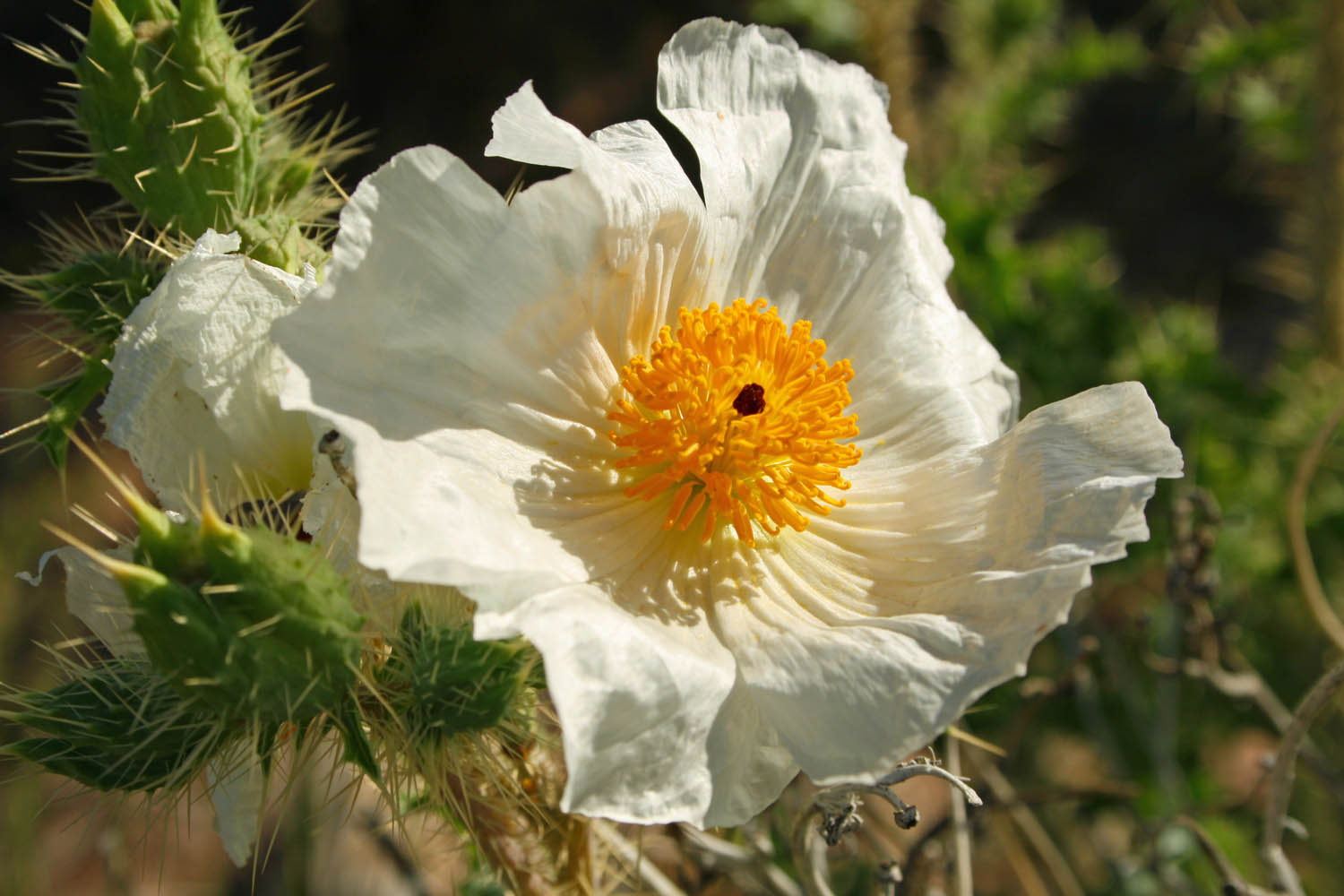
|
Family: Papaveraceae |
Herbs or subshrubs , annual or perennial, caulescent, glaucous, from transitory or persistent taproots; sap white to orange. Stems leafy, branching. Leaves sessile; basal rosulate, cauline alternate; blade unlobed or commonly shallowly to deeply 1×-lobed; margins dentate, each tooth terminated by prickle; surfaces glaucous, often mottled over veins, unarmed or prickly, glabrous or hispid. Inflorescences terminal, cymose; bracts present. Flowers conspicuous, sometimes subtended by foliaceous bracts; sepals 2 or 3, unarmed or prickly, each with erect, subterminal, hollow horn tipped with prickle; petals 6, in 2 whorls of 3; stamens 20-250 or more; pistil 3-5(-7)-carpellate; ovary 1-locular; style short, to 3 mm in fruit; stigma 3-5(-7)-lobed. Capsules erect, 3-5(-7)-valved, grooved over sutures, prickly, rarely unarmed, dehiscing from apex ca. 1/3 length, valves separating from framework of vascular elements, to which persistent style and stigma remain attached. Seeds numerous, subglobose, minutely pitted, 1-3 mm, aril present. x = 14. None of the North American species occurs in South America except for the pantropical weeds Argemone mexicana and, probably, A . ochroleuca . Argemone glauca is endemic to Hawaii. Three suffrutescent, perennial species are known from Mexico in Coahuila ( A . fruticosa ) and Chihuahua ( A . turnerae , A . ownbeyana ). Most herbaceous species can be hybridized, but the F 1 plants are sterile when the parents differ in ploidy level. The F 2 generation, when achieved, consists mainly of plants of low vigor. The alkaloids of Argemone have been studied extensively. F. S. Stermitz (1968) has suggested that the species fall into four groups (one with two subgroups) according to their alkaloidal properties, and that these groups coincide to a considerable degree with the informal species alliances suggested by G. B. Ownbey (1958). A full evaluation of the importance of alkaloidal content to Argemone taxonomy and evolution has not been published, but there is little doubt that it is highly significant. The name Argemone intermedia Sweet (Hort. Brit. ed. 2, 1830) is encountered in several regional and local floras but is of uncertain application.
PLANTS: Annual or perennial herbs or shrubs. STEMS: 0.5-1.2 m or more tall, l-many from the base, branched above, all axes determinate, prickly, rarely smooth, glaucous. LEAVES glaucous, often mottled, sessile; margin dentate, each tooth terminated by a spine; blade shallowly to deeply lobed, rarely unlobed, the surface smooth to closely prickly. INFLORESCENCE: cymose. FLOWERS: conspicuous, perfect, trimerous; buds smooth to prickly; sepals caducous, imbricated each with a single erect subterminal prickle-tipped, saccate process, the sepal hom; petals 6, in two whorls of 3, white or yellow (in ours), pink, purple or bronze; stamens 20-150 or more; ovary unilocular, 3-5-carpellate. FRUITS: prickly capsules (rarely smooth), dehiscing apically for about one-third their length, the carpellary wall separating at the sutures from a framework of vascular elements which are attached apically to the persistent style and stigma. SEEDS: numerous pitted. 2N = 28, 56, 84, 112. NOTES: 31 spp.; s and sw U.S., Mex., C. Amer., S. Amer., HI. (Greek name of a poppy-like plant). Extracts of the plant are used in folk medicine. The alkaloidal constituents of most species have been identified. REFERENCES: Ownbey, Gerald B., Jeffrey W. Brasher, and Curtis Clark. 1998 Papaveraceae. J. Ariz. - Nev. Acad. Sci. 30(2): 120. Stems, lvs, and sep spiny; sep generally 3; pet generally 6; ovary unilocular, with 4-6 parietal placentas; style short or none; stigma dilated, 4-6-radiate; capsule spiny, the upper third opening by valves; coarse herbs with thistle-like foliage and large fls terminating the branches; juice in our spp. yellow. 20, New World. Gleason, Henry A. & Cronquist, Arthur J. 1991. Manual of vascular plants of northeastern United States and adjacent Canada. lxxv + 910 pp. ©The New York Botanical Garden. All rights reserved. Used by permission. |
This project was made possible in part by the Institute of Museum and Library Services [MG-70-19-0057-19].
Powered by Symbiota



